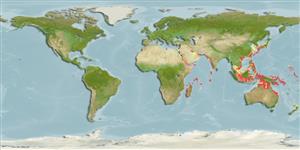>
Ophidiiformes (Cusk eels) >
Bythitidae (Livebearing brotulas)
Etymology: Microbrotula: Greek, mikros = small + Latin, brotula, -ae = little, bud, shoot (Ref. 45335); bentleyi: Named for Andrew Charles Bentley of Port Elizabeth, South Africa, now at the University of Kansas, USA, for his enthusiasm and help in the development of a program on western Indian Ocean fishes, and for collecting the holotype..
Environment: milieu / climate zone / depth range / distribution range
Ecologia
marino associati a barriera corallina; distribuzione batimetrica 0 - 55 m (Ref. 54832). Tropical
Indo-Pacific: South Africa to the Red Sea and from the Philippines to Cape York Peninsula in northern Australia; widely distributed and large gap in the distribution is probably a collecting artefact rather than indicative of a true distribution.
Size / Peso / Age
Maturity: Lm ? range ? - ? cm
Max length : 4.0 cm SL maschio/sesso non determinato; (Ref. 54832); 4.1 cm SL (female)
Short description
Morfologia | Morfometria
Raggi dorsali molli (totale): 61-70; Raggi anali molli: 50 - 57; Vertebre: 44 - 47. This species is distinguished by the following characters: vertebrae 11-12+33-35=44-47; fin rays, on dorsal 61-70, anal 50-57, pectoral 15-17, caudal 7-8; anterior dorsal fin ray above vertebra number 7-8, anterior anal fin ray below dorsal fin ray number 12-16, anterior anal fin ray below vertebra 13-16; small forward-curved spine at lower angle of preopercle, hidden by skin; fleshy interorbital width 4.5-7.0% SL; palatine teeth papillae-like or absent (Ref. 88975).
Found from near the surface to 55 meters in protected reef structures (Ref. 54832). Solitary inhabitant of reef crevices, cryptic (Ref 90102).
Life cycle and mating behavior
Maturità | Riproduzione | Deposizione | Uova | Fecundity | Larve
Schwarzhans, W. and J.G. Nielsen, 2011. Revision of the genus Microbrotula (Teleostei: Bythitidae), with description of two new species and a related new genus. The Beagle, Records of the Museums and Art Galleries of the Northern Territory 27:147-160. (Ref. 88975)
IUCN Red List Status (Ref. 130435)
Threat to humans
Harmless
Human uses
Informazioni ulteriori
Nomi ComuniSinonimiMetabolismoPredatoriEcotossicologiaRiproduzioneMaturitàDeposizioneSpawning aggregationFecundityUovaEgg development
Age/SizeAccrescimentoLength-weightLength-lengthLength-frequenciesMorfometriaMorfologiaLarveDinamica popolazioni larvaliReclutamentoAbbondanzaBRUVS
BibliografiaAcquacolturaProfilo di acquacolturaVarietàGeneticaElectrophoresesEreditarietàMalattieElaborazioneNutrientsMass conversion
CollaboratoriImmaginiStamps, Coins Misc.SuoniCiguateraVelocitàModalità di nuotoArea branchialeOtolithsCervelliVista
Strumenti
Special reports
Download XML
Fonti Internet
Estimates based on models
Preferred temperature (Ref.
123201): 22.9 - 29, mean 27.5 °C (based on 576 cells).
Phylogenetic diversity index (Ref.
82804): PD
50 = 0.5039 [Uniqueness, from 0.5 = low to 2.0 = high].
Bayesian length-weight: a=0.00457 (0.00179 - 0.01169), b=3.10 (2.87 - 3.33), in cm total length, based on LWR estimates for this (Sub)family-body shape (Ref.
93245).
Trophic level (Ref.
69278): 3.2 ±0.5 se; based on size and trophs of closest relatives
Resilienza (Ref.
120179): Alto, tempo minimo di raddoppiamento della popolazione meno di 15 mesi (Preliminary K or Fecundity.).
Fishing Vulnerability (Ref.
59153): Low vulnerability (10 of 100).
